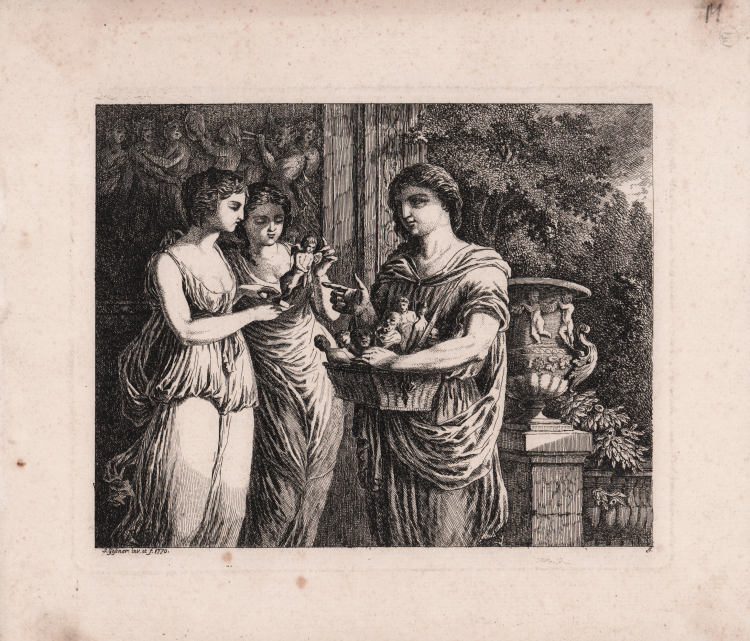



| Reference: | S42001 |
| Author | Samuel GESSNER |
| Year: | 1770 |
| Measures: | 195 x 155 mm |


| Reference: | S42001 |
| Author | Samuel GESSNER |
| Year: | 1770 |
| Measures: | 195 x 155 mm |
Etching, signature and date at lower left: “S. Gessner inv. et f. 1770”.
Gessner was undoubtedly one of the most significant representatives of the European Enlightenment in the second half of the eighteenth century, because he was able to interpret the new artistic and literary impulses of the time in an original way and at the same time in keeping with contemporary taste and ideas.
In his poetic work as in the pictorial one, the recovery of the idyllic element typical of the classicist formulas of the Hellenistic pastoral poetry is harmonized and enriched by a subjective, modern and enlightened look at nature.
At the end of the 1700s, the "Gessnerische Gemälde-Kabinett," i.e., the Cabinet that collected the paintings of Salomon Gessner, was considered one of the most important artistic centers in Zurich.
The collection, which included some twenty gouaches and watercolors as well as 17 drawings and prints, was located in Gessner's private apartment at Münstergasse 9, and was set up by his family in the form of a cabinet after his death. It was the first private collection of paintings to be opened to the public in Zurich, and after being purchased by the city, it was returned in 1818 as a permanent loan to the art society of the time, which later merged into today's Zürcher Kunstgesellschaft.
Salomon Gessner's Cabinet remained on display until the first half of the 19th century before disappearing into the storage rooms of the Kunsthaus, from where it has now resurfaced in the excellent reconstruction conducted by the curator of the museum's Prints and Drawings Department, Bernhard von Waldkirch.
Beautiful proof, printed on contemporary laid paper, with margins, in perfect condition.
Samuel GESSNER (Zurigo 1730 - 1788)
|
After an interrupted apprenticeship as a bookseller in Berlin (1749-1750), Gessnes became a publisher in Zurich. In his father's business, which he took over in 1775, he edited the Montags-Zeitung until 1760, then from 1772 to 1779. He founded the Zürcher Zeitung (Neue Zürcher Zeitung from 1821) in 1780 and was a partner in Orell, Gessner & Co. (Orell, Gessner, Füssli & Co. from 1770 to 1798), the leading publishing house of the Swiss Enlightenment. He represented the Mésange guild in the Grand Council in 1765 and in the Petit Conseil in 1767. From 1768 to 1777, Gessner was bailiff of Erlenbach, then of the Vier Wachten and of Wipkingen, and in 1781 administrator of the Sihl forest (Sihlherr). He was also a member of the city library committee from 1758, a partner and artistic director of the Zurich porcelain factory in Kilchberg (1763) and deputy administrator of the scientific art school (1772). He was one of the founders of the Helvetic Society in 1760.
Gessner gained European fame as a poet and painter of idylls remarkable for their openness. His rhythmic prose renewed the baroque language. Among his works, which were all printed in his publishing house, sometimes in Roman type instead of German Gothic, the fifty-two idylls published between 1756 and 1772 are the best known. Gessner illustrated with engravings his works and those of others published by him. He painted more than a hundred Arcadian idyllic landscapes and drew some 600 life studies. The whole of his work makes him a prominent creator in the field of publishing and a painter with a strong style, who perfectly expressed the dream of the animated nature.
|
Samuel GESSNER (Zurigo 1730 - 1788)
|
After an interrupted apprenticeship as a bookseller in Berlin (1749-1750), Gessnes became a publisher in Zurich. In his father's business, which he took over in 1775, he edited the Montags-Zeitung until 1760, then from 1772 to 1779. He founded the Zürcher Zeitung (Neue Zürcher Zeitung from 1821) in 1780 and was a partner in Orell, Gessner & Co. (Orell, Gessner, Füssli & Co. from 1770 to 1798), the leading publishing house of the Swiss Enlightenment. He represented the Mésange guild in the Grand Council in 1765 and in the Petit Conseil in 1767. From 1768 to 1777, Gessner was bailiff of Erlenbach, then of the Vier Wachten and of Wipkingen, and in 1781 administrator of the Sihl forest (Sihlherr). He was also a member of the city library committee from 1758, a partner and artistic director of the Zurich porcelain factory in Kilchberg (1763) and deputy administrator of the scientific art school (1772). He was one of the founders of the Helvetic Society in 1760.
Gessner gained European fame as a poet and painter of idylls remarkable for their openness. His rhythmic prose renewed the baroque language. Among his works, which were all printed in his publishing house, sometimes in Roman type instead of German Gothic, the fifty-two idylls published between 1756 and 1772 are the best known. Gessner illustrated with engravings his works and those of others published by him. He painted more than a hundred Arcadian idyllic landscapes and drew some 600 life studies. The whole of his work makes him a prominent creator in the field of publishing and a painter with a strong style, who perfectly expressed the dream of the animated nature.
|